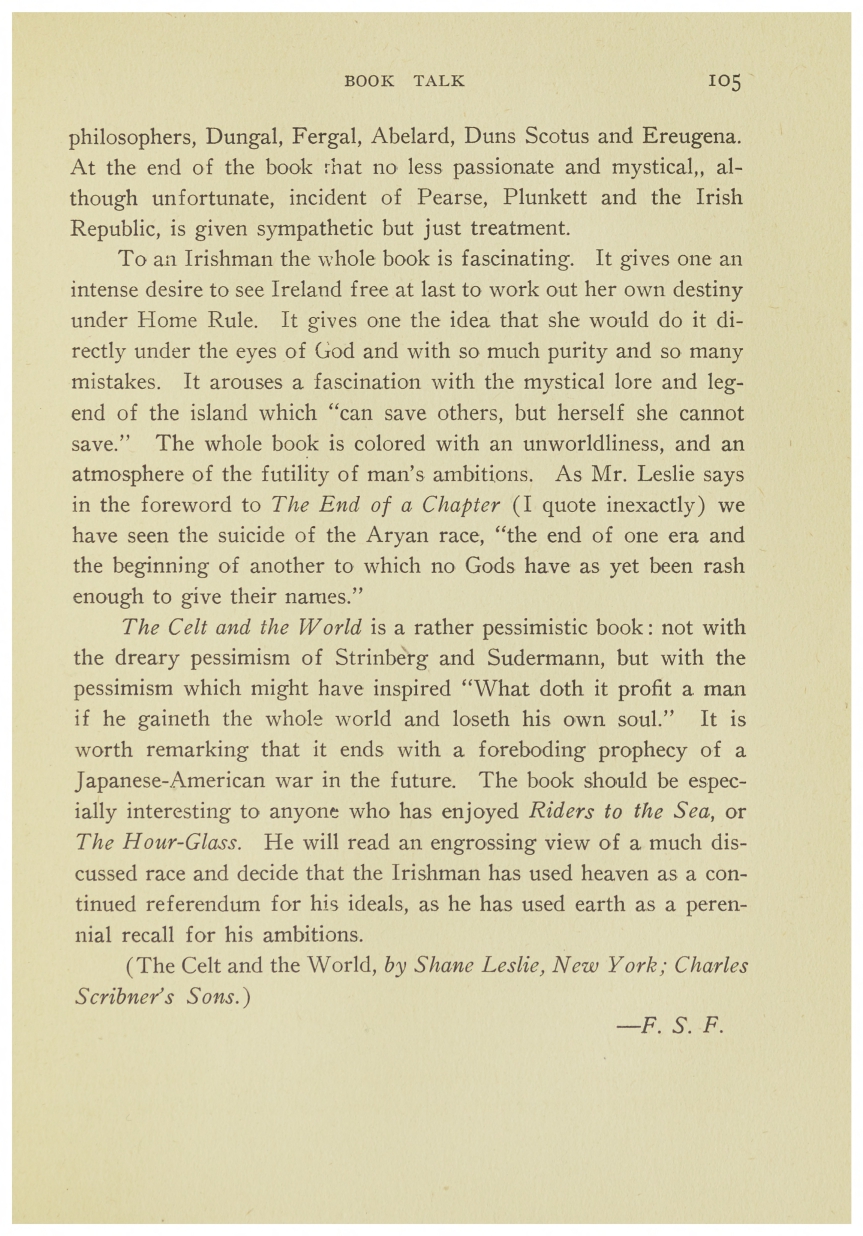
Review of Shane Leslie’s “The Celt and the World”
by F. Scott Fitzgerald
After his most entertaining End of a Chapter, Mr. Leslie1 has written what I think will be a more lasting book. The Celt and the World is a sort of bible of Irish patriotism. Mr. Leslie has endeavored to trace a race, the Breton, Scotch, Welsh, and Irish Celt, through its spiritual crises, and he emphasizes most strongly the trait that Synge, Yeats and Lady Gregory2 have made so much of in their plays, the Celt’s inveterate mysticism. The theme is worked out in an era-long contrast between Celt and Teuton, and the book becomes ever ironical when it deals of the ethical values of the latter race. “Great is the Teuton indeed,” it says, “Luther in religion, Bessemer in steel, Nietzsche in philosophy, Rockefeller in oil—Cromwell and Bismarck in war.” What a wonderful list of names! Could anyone but an Irishman have linked them in such damning significance?
In the chapter on the conversion of the Celt to Christianity, is traced the great missionary achievements of the Celtic priests and philosophers, Dungal, Fergal, Abelard, Duns Scotus and Ereugena. At the end of the book that no less passionate and mystical, although unfortunate, incident of Pearse, Plunkett and the Irish Republic is given sympathetic but just treatment.3
To an Irishman the whole book is fascinating. It gives one an intense desire to see Ireland free at last to work out her own destiny under Home Rule. It gives one the idea that she would do it directly under the eyes of God and with so much purity and so many mistakes. It arouses a fascination with the mystical lore and legend of the island which “can save others, but herself she cannot save.”4 The whole book is colored with an unworldliness, and an atmosphere of the futility of man’s ambitions. As Mr. Leslie says in the foreword to The End of a Chapter (I quote inexactly) we have seen the suicide of the Aryan race, “the end of one era and the beginning of another to which no Gods have as yet been rash enough to give their names.”
The Celt and the World is a rather pessimistic book: not with the dreary pessimism of Strindberg and Sudermann,5 but with the pessimism which might have inspired “What doth it profit a man if he gaineth the whole world and loseth his own soul.” It is worth remarking that it ends with a foreboding prophecy of a Japanese-American war in the future. The book should be especially interesting to anyone who has enjoyed Riders to the Sea or The Hour-Glass.6 He will read an engrossing view of a much discussed race and decide that the Irishman has used heaven as a continued referendum for his ideals, as he has used earth as a perennial recall for his ambitions.
(The Celt and the World, by Shane Leslie, New York; Charles Scribner’s Sons.)
—F.S.F.
Notes
1. The End of a Chapter was published in 1917. Shane Leslie (1885-1971) was an Anglo-Irish writer who encouraged the young Fitzgerald’s literary ambitions.
2. Dramatist John Millington Synge (1871-1909), poet and dramatist William Butler Yeats (1865-1939), and dramatist Lady Augusta Gregory (1852-1932)—prominent figures in the Irish literary renaissance.
3. Irish Republicans Patrick Pearse (1879-1916) and Joseph Plunkett (1887-1916) were leaders of the April 1916 Easter Rebellion against English forces in Dublin. Both were executed in May 1916.
4. Fitzgerald echoes Matthew 27:42: “He saved others; himself he cannot save,” words of those reviling Christ at his crucifixion.
5. Swedish dramatist August Strindberg (1849-1912) and German dramatist Hermann Sudermann (1857-1928).
6. Play by Synge first produced in 1904 and play by Yeats first produced in 1903.
Published in The Nassau Literary Magazine (May 1917).
Not illustrated.

